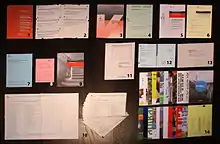Semi-direct democracy
Semi-direct democracy is a type of democracy that combines the mechanisms of direct democracy and representative government. In semi-direct democracy, representatives administer daily governance, but citizens keep the sovereignty, being able to control their governments and laws through different forms of popular action: binding referendum, popular initiative, revocation of mandate, and public consultations. The first two forms—referendums and initiatives—are examples of direct legislation.
History
Modern-era citizen lawmaking began in the towns of Switzerland in the 13th century. In 1847, the Swiss added the "statute referendum" to their national constitution. They soon discovered that merely having the power to veto Parliament's laws was not enough. In 1891, they added the "constitutional amendment initiative". Swiss politics since 1891 have given the world a valuable experience base with the national-level constitutional amendment initiative.[1] In the past 120 years, more than 240 initiatives have been put to referendums. The populace has been conservative, approving only about 10% of these initiatives; in addition, they have often opted for a version of the initiative rewritten by government.[2][3][4][5]
Application
A government is elected, but unlike the representative system, there are binding mechanisms of control, where the people take power and can veto laws of parliament, or propose new laws, which will subsequently be subject to a binding referendum. These mechanisms are the binding referendum and the popular legislative initiative. There are other mechanisms such as the revocation of the mandate, the avocation and the plebiscite. The main countries of application are Switzerland and Liechtenstein.
Switzerland

The pure form of direct democracy exists only in the Swiss cantons of Appenzell Innerrhoden and Glarus.[6] The Swiss Confederation is a semi-direct democracy (representative democracy with strong instruments of direct democracy).[6] The nature of direct democracy in Switzerland is fundamentally complemented by its federal governmental structures (in German also called the Subsidiaritätsprinzip).[2][3][4][5]
Most western countries have representative systems.[6] Switzerland is a rare example of a country with instruments of direct democracy (at the levels of the municipalities, cantons, and federal state). Citizens have more power than in a representative democracy. On any political level citizens can propose changes to the constitution (popular initiative), or ask for an optional referendum to be held on any law voted by the federal, cantonal parliament and/or municipal legislative body.[7]
The list for mandatory or optional referendums on each political level are generally much longer in Switzerland than in any other country; for example any amendment to the constitution must automatically be voted on by the Swiss electorate and cantons, on cantonal/communal levels often any financial decision of a certain substantial amount decreed by legislative and/or executive bodies as well.[7]
Swiss citizens vote regularly on any kind of issue on every political level, such as financial approvals of a school house or the building of a new street, or the change of the policy regarding sexual work, or on constitutional changes, or on the foreign policy of Switzerland, four times a year.[8] Between January 1995 and June 2005, Swiss citizens voted 31 times, on 103 federal questions besides many more cantonal and municipal questions.[9] During the same period, French citizens participated in only two referendums.[6]
In Switzerland, simple majorities are sufficient at the municipal and cantonal level, but at the federal level double majorities are required on constitutional issues.[1]
A double majority requires approval by a majority of individuals voting, and also by a majority of cantons. Thus, in Switzerland a citizen-proposed amendment to the federal constitution (i.e. popular initiative) cannot be passed at the federal level if a majority of the people approve but a majority of the cantons disapprove.[1] For referendums or propositions in general terms (like the principle of a general revision of the Constitution), a majority of those voting is sufficient (Swiss Constitution, 2005).
In 1890, when the provisions for Swiss national citizen lawmaking were being debated by civil society and government, the Swiss adopted the idea of double majorities from the United States Congress, in which House votes were to represent the people and Senate votes were to represent the states.[1] According to its supporters, this "legitimacy-rich" approach to national citizen lawmaking has been very successful. Kris Kobach claims that Switzerland has had tandem successes both socially and economically which are matched by only a few other nations. Kobach states at the end of his book, "Too often, observers deem Switzerland an oddity among political systems. It is more appropriate to regard it as a pioneer." Finally, the Swiss political system, including its direct democratic devices in a multi-level governance context, becomes increasingly interesting for scholars of European Union integration.[10]
United States
Some of the states of United States have a form of semi-direct democracy where citizens can start the referendum process if they are able to gather enough petition signatures. If enough petition signatures are gathered then the entire state's electorate can vote to approve or disapprove of the ballot measure.
References
- Kobach 1993
- Hirschbühl (2011a).
- Hirschbühl (2011b).
- Hirschbühl (2011c).
- Hirschbühl (2011d).
- Vincent Golay and Mix et Remix, Swiss political institutions, Éditions loisirs et pédagogie, 2008. ISBN 978-2-606-01295-3.
- "Referendums". ch.ch – A service of the Confederation, cantons and communes. Berne, Switzerland: Swiss Confederation. Archived from the original on 2017-01-10. Retrieved 2017-01-09.
- Julia Slater (28 June 2013). "The Swiss vote more than any other country". Berne, Switzerland: swissinfo.ch – the international service of the Swiss Broadcasting Corporation. Retrieved 2015-07-27.
- Duc-Quang Nguyen (17 June 2015). "How direct democracy has grown over the decades". Berne, Switzerland: swissinfo.ch – the international service of the Swiss Broadcasting Corporation. Archived from the original on 21 September 2015. Retrieved 2015-07-27.
- Trechsel (2005)
Bibliography
- Hirschbühl, Tina (2011b), The Swiss Government Report 2, Federal Department of Foreign Affairs FDFA, Presence Switzerland – via YouTube
- Hirschbühl, Tina (2011c), How Direct Democracy Works In Switzerland – Report 3, Federal Department of Foreign Affairs FDFA, Presence Switzerland – via YouTube
- Hirschbühl, Tina (2011d), How People in Switzerland Vote – Report 4, Federal Department of Foreign Affairs FDFA, Presence Switzerland – via YouTube
- Hirschbühl, Tina (2011e), Switzerland & the EU: The Bilateral Agreements – Report 5, Federal Department of Foreign Affairs FDFA, Presence Switzerland – via YouTube
- Kobach, Kris W. (1993). The Referendum: Direct Democracy In Switzerland. Dartmouth Publishing Company. ISBN 9781855213975.
.svg.png.webp)
